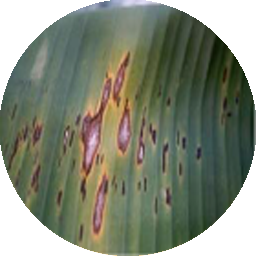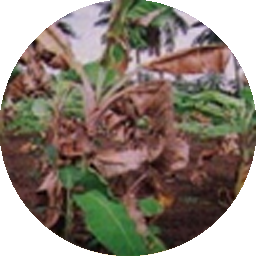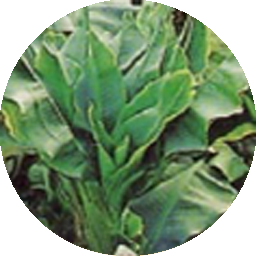Banana Symptoms & Management
×
Symptoms:
1.Early symptoms appear on the lower leaves.
2.Initially small reddish brown specks develop on leaves near the tip or margin of lamina.
3.Specks may also be produced near the midrib.
4.Specks increase in size and turn in to spindle shaped spots with reddish brown margin and gray centre surrounded by a yellow halo.
5. Spots formed near the midrib enlarge and extend towards the margin of lamina.
6. Spots coalesce and the entire spotted area appears dried.
7. Disease gradually progresses on to upper leaves.
8. Infection becomes severe after bunch emergence with the entire foliage infected under favorable conditions.
9. Fruits in bunches of infected plants are under developed and may ripen Prematurely.
Management:
1. Planting banana in well drained soils
2. Growing moderately resistant cultivars like Karpura Chakkerakeli
3. Planting at recommended density (1000 plants/acre)
4. Prunning suckers periodically to avoid overcrowding in the field
5. Removal and destruction of affected leaves followed by spraying with BM 1% + linseed oil 2%
6. Applying recommended dose of potassium fertilizer
7. Spraying mancozeb or cholorothalonil 0.2% suspended in mineral (paraffin) oil
8. Spraying chlorothalonil 0.2% with non ionic adhesive in pre-monsoon period and propiconazole 0.1% interspersed with tridemorph 0.1% at 20 days interval in rainy period
×
Symptoms:
1.Fungus attacks roots and finds its way in to the pseudostem
2.Conspicuous symptoms usually appear on 3 to 5 months old plants, although 2-3 months old plants are also killed under highly favourable conditions
3.Symptoms initially seen in older plants in a mat
4.The earliest symptoms are faint yellow streaks on the petiole of oldest, lower most leaves
5.Affected leaves show progressive yellowing, break at the petiole and hang down along the pseudostem
6.Longitudinal splitting of pseudostem is very common
7.Light yellow to dark brown discolouration of vascular strands in pseudostem. Usually the discolouration appears first in the outer or oldest leaf sheath and extends in to then inner sheaths
8.The fungus grows and blocks the vascular system resulting in wilting of the plant
9.Vascular discolouration in cross sections of rhizome appears reddish brown towards periphery progressing in to centre of rhizome
10.Rhizomes of affected plants give characteristic odour of rotten fish if infection is due to odoratum isolate of the pathogen
11.Young suckers also develop the disease but rarely develop external symptoms
12.Affected plants do not produce bunches. Even if produced, fruits are malformed and ripen prematurely or irregularly. However the pathogen does not infect the fruits
Management:
1.Use of disease free suckers for planting
2.Avoid ill drained soils
3.Flood fallowing for 6 to 24 months or crop rotation with puddle rice
4.Application of lime (1-2 kg/pit) to the infected pits after chopping of the plants parts
5.Dipping of suckers in carbendazim (0.1%) solution before planting
6.Neem cake + Trichoderma viride should be applied in planting pits
7.Soil drench with 0.2% carbendazim or rhizome injection with 0.2% carbendazim
8.Growing resistant Cavendish varieties, viz., Basrai (Vamanakeli or Dwarf cavendish), Poovan (Karpura chakkarakeli) etc.
×
Symptoms:
1.Infection may start at any stage of crop growth
2.Paling of lamina with interveinal chlorosis that is evident against light
3.Prominent dark green streaks on the petioles and along midrib and leaf veins that range from a series of dark green dots to a continuous dark green line (Morse code)
4.Infected plants show marked stunting
5.Leaves are reduced in size with narrowed lamina and shortened petiole, produced at shortened internodal length, become erect and brittle and crowded at the top (bunchy top)
6. Leaf margins also show chlorosis and slight curling and necrosis
7. Infection of young plants leads to failure of bunch emergence
8.Tips of inflorescence bracts of infected plants remain green and do not turn to normal pink or purple
Management:
1. Adoption of strict quarantine measures
2. Use of only certified banana suckers or tissue culture plants for planting
3. Periodical monitoring and rouging of infected plants with all suckers in the mat by rouging or killing by injecting herbicide, 2, 4-D
4. Raising barrier crops like sunhemp in three to four rows on the field boundaries to check Aphids from entering the fields from neighbouring infected fields
5. Vector control with systemic insecticides, viz., Phosphomidon @ 1ml/l or Methyl demeton or Dimethoate @ 2 ml/l
6. Discouraging intercropping with Colocasiai in disease endemic areas
7. Banana Mosaic / Infectious chlorosis / Heart rot: Cucumber Mosaic Virus (CMV)
8.The virus is a domestic quarantine pest in India. Hence movement of planting suckers from Gujarat and Maharashtra to other parts of the country is banned



